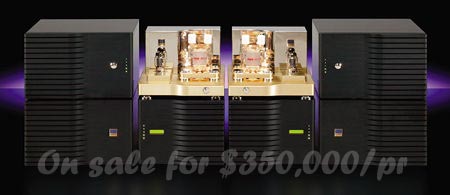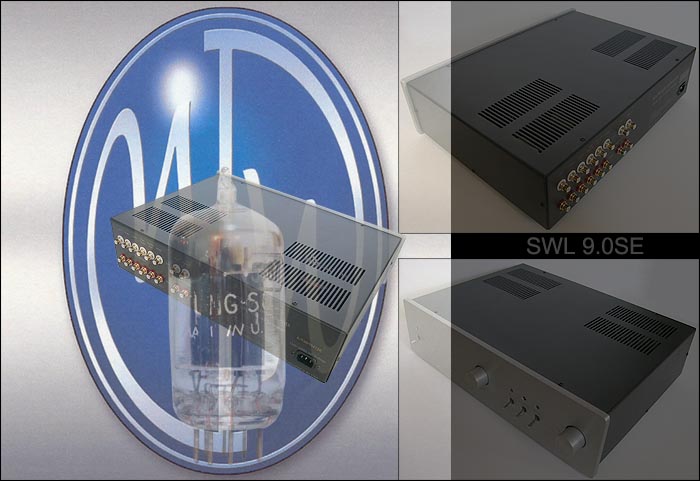|
This review page is supported in part by the sponsor whose ad is displayed above
|
||||||||||||||||||||||||
 |
||||||||||||||||||||||||
| Part and parcel of being a reviewer is that over time, our systems tend to brave the forboding slopes of Mount Mammon with ever greater zeal. There are perhaps no upgrade whores in audiodom more skilled and busier than our kind. It's a serious professional liability. Police men might get shot at, reviewers slowly but surely go ape. That has benefits. The most obvious one is gaining access to the crème de la crop. After all, there are only so many reviewers with Wilson Audio Alexandrias, Rockport Sirius turntables or Vladimir Lamm's finest properly equipped to judge in these leagues with actual experience. These writers become the go-to guys when companies need their statement products reviewed. An associated fringe benefit is perception. The professional with the most expensive -- and presumably best -- tools is the 9th-grade black belt of the group. He's the master samurai all others look up to. It's called credibility. It's part of the game. Once a publication gains access to ultimate components by having its very own J10 and JV, its standing in the global community reaches a new plateau. That attracts further benefits by magnetism. And so forth and sin no more. |
||||||||||||||||||||||||
| On the dark side of this same ledger is that you can write yourself into oblivion, preaching to an ever-shrinking congregation. Yes, we all love to dream. Don't we? Eventually though, the bridge between reality and dreams stretches so precariously thin that we stand to lose the most important part of our audience. Those who are the most passionate and curious precisely because they're not jaded yet; those just getting into the hobby who have to artfully balance their audiophile Jones against wicked college | ||||||||||||||||||||||||
 |
||||||||||||||||||||||||
| tuitions, hospital bills, car loans, aging parents, leaky roofs and all the various real-world expenses that bedevil the average family. Them's the crowd we want to write for, something certainly not helped if ye olde Editor runs amok. My main rig has been pushing south of the $70K border for a while. Not very democratic at all. My personal wake up call came by way of Anthony Gallo's overachieving Reference 3. For $2,590/pr, they aren't the world's best speakers but for all sane intents and purposes, they might as well be. The arrival of Zu Cable's Druids merely compounded this move back to rhyme & reason and ecstasy for a relative song. Ever since, I've been deliberating on how to strategically climb down Mount Olympus all across the board while remaining in the reflected light of its snow-covered peak. Downscale. Simplify. Strip costs with minimum penalties to audible performance or vital features and don't accept outright compromises at all. One fringe benefit of said approach is that reviewing significantly more expensive components will henceforth make it that much harder to justify their expense - unless they're clearly superior all around (and the question still remains, by how much really). Reviewing for a living means I have to first replace what I hope to sell or else I'd be like a carpenter without a hammer. Hence my personal journey back into the land of the living rather than dreaming will occur in spurts and sputters as I come across the right components and can afford to foot the bill. All this preamblizing to identify my first electronic candidate, Dan Wright's SWL 9.0SE. I am buying the review unit to downscale in preamp land by more than 50%. The reasons for my choice are simple and straightforward. I believe in additive preamps. If a preamp does nothing but source switching and volume control, I'd rather not have one. I'm a one source guy and the Audio Aero Prima SE performs switching and volume (as does the $3,000 Consonance Droplet CDP 5.0, the Cary and plenty of other still-affordable one-box CD players). A preamp in my book has to justify its inclusion by adding dynamics, body, tone and spatial dimensionality. For me, that means tubes. Alas, not just any tubes. Unless a valved unit's noise floor was buried 6 foot under and its bandwidth exploded, it would by definition veil certain ambient micro details which a superior source clearly resolves. That's called 2 steps forward, one back. Not on my watch. You expect smaller advances with lower pricing. That's fair enough. But you need not settle for counter-productive results that steal from Jane to pay Jimbo. |
||||||||||||||||||||||||
 |
My personal set of requirements further mandates just the right kind of gain structure so 100dB+ speaker efficiencies remain copasetic. No remote volume control wouldn't be a deal breaker if everything else checked out but definitely makes the wish list if available. Last but not least, the new mandate of sanity stipulates that the price must be such that the average music lover can afford it (granted, that's a matter of interpretation and everyone has a different pain threshold and priorities). ModWright has proven their legitimacy as a business as much as such things can be proven. Considering their new preamp for ownership isn't just about price shopping. It's about getting the whole nine yards of service, support and longevity. But how does this preamp perform in the big rig? |
|||||||||||||||||||||||
| Despite their small size, those 5687s triodes have gonads the size of premium prunes, not raisins. I first understood this when Ray Samuels' Raptor [below], designed for Grado or Sennheiser headphones, drove my 74dB/1w/1m abnormal AKG K1000s without distortion or lack of control and to very realistic levels. This atypical current delivery for a small signal valve here audibly translates as articulation across the board. Think banishment of fuzzy edges and soft focus. Think excellent bass control while you're at it. You might protest how this aspect properly belongs in the amplifier's, not preamplifier's realm of responsibilities. I sympathize since it's the amplifier's output current that mandhandles your speakers' drivers, not the preamp. Still, going from a particular 6SN7-based preamp to ModWright's 5687 unit did |  |
|||||||||||||||||||||||
| demonstrate without fail that testicular fortitude in a preamp nets plain dividends through the following amplifier. The SWL is taut and snappy, not loose, indistinct, dark or veiled. It isn't bloomy either in how minor fuzziness around the edges can often be mistaken for bloom. It's a pile driver of a preamp and pushy in a sense of action rather than passivity. There is a modicum of additive tone but it stops well short of euphonia for a very modern distillation of this tube trait rather than a vintage indulgence. Linear extension to 200kHz guarantees no blunted treble or HF phase errors. Meanwhile, the common solid-state quality of chalkiness or wiry flatness in the high end is completely transcended. Likely because of the high current/drive factor, a very noticeable strength of the SWL 9.0 is fullness at low volumes. |
||||||||||||||||||||||||
| Like cars, audio components have optimized RPM/torque envelopes where RPM relates to volume. Some cars don't begin to really pull and accelerate until you're in third gear. Sports cars may be able to reach 50mph in 1st gear alone. ModWright's preamp has sportscar-like torque. You needn't goose it to get into its sweet spot. Especially during in-store demonstrations, this is often overlooked. But when reason returns -- ordinary life and neighbors -- |  |
|||||||||||||||||||||||
| and even excess (listening at 3:00AM in the wee hours), it's one of the most vital qualities. Is your system satisfying at low volumes? Does it sound bleached, pale and wan like someone bed-ridden who needs to get out and in the sun? How far do you have to crank the throttle until treble and bass show up and integrate fully? Of course some of that is psychoacoustics - but not all. When you compare components, a simple test is to start the volume at dead zero and incrementally inch your way up until the sound, top to bottom, locks in. Beyond that point, nothing changes except scale. Before that point, certain things are missing or only hinted at. The lower that point, the better. TJ's valve slogan is Full Music. That's a truly apt descriptor for this effect. How soon does the full music factor kick in? Very early with the SWL 9.0SE. Tubes are voltage devices, voltage swings their playground. That means dynamics. An amplifier's job is to translate voltage into current to force transducer motion into conformity with the signal. A preamp's job is to magnify dynamic differentials in the small-signal domain so the amplifier can expand these differences for maximum effect from pppp to ffff. Needless to say, dynamic contrasts are easy on the gross scale. The decibel spread from loudest to quietest is so huge as to be blatant. Far more important is to expand the tiny steps so they appear as discrete values and not one homogenized blur. Anyone who has ever burned digital copies on a stand-alone CDR recorder knows how most recordings are so compressed that your signal strength needle (or digital bars) barely move throughout a whole cut. Some literally only flicker between 3dB of dynamic scale. If these poles of loudest to quietest are like neighbors on a narrow bench, there's no room for anyone else. Everything sounds the same - loud or not so loud. That's pretty nebulous. What's needed is a far longer bench to accommodate a far more varied crowd of intermediate values. Enter the dynamo that is the 5687 triode and also appears in the new Border Patrol control amp, Emotive Audio's Sira, Zenn Audio's ZPL2, Audio Note's M7, Wyetech Labs' Coral (and Sapphire as driver for its paralleled 300Bs) and even the legendary Ongaku as a cathode follower. Simply put, it's a dynamic expander. Think stretch limousine-style bench for our simile. It's apparently also a very linear tube without excessive THD. That means precision and accuracy but less tonal enhancements than the 6SN7 which appears in all of Wyetech's preamps above the Coral. Think very mild taste of triode here. It's in the layering and holography dimension where the tube virtues come to the fore again, performing the expander action already noted in the dynamic domain especially when compared to most transistor-based units of comparable or higher price. The Bel Canto Design PRe2 is a superior example of a solid-state preamp that possesses just the slightest sheen of texture to avoid blandness. Where it truly excels is with data retrieval. Only a very good tube-based preamp can pass that much detail simply because its higher operational noise floor buries some of it. |
||||||||||||||||||||||||
 |
||||||||||||||||||||||||
It's here where Dan's SWL 9.0SE deserves the highest praise for refusing to play second fiddle against its superior sand brethren. The -- untold -- stories of tube amp designers getting into preamps only to be confounded by noise issues are legion. Grounding and shielding as well as microphony issues become elusive to track down but vital to master. Designing a good-sounding valve linestage doesn't seem too difficult. Designing one that's truly quiet? This is where boyz either become men or remain perennially adolescent. You'll see S/N ratios of 80dB proffered as tokens of pride when your average CD player produces 100dB and world beaters claim to approach 120dB. Talk about bottle necks! Bel Canto specs their PRe2 as 100dB A-weighted. This suggests that the SWL 9.0 by comparison is real close, truly excellent performance for valves. For a real-world test, I ran it into the Red Wine Audio Clari-T custom. In Michael Lavorgna's immortal words, the battery-powered Clari-T is so bereft of its own noise floor that your bleeding heartbeat is louder. Thus eliminating the amp from contributing its own din, I next stuck my ears into the Druid's 101dB efficient drivers while opening the 9.0's gain control. It turns out the Clari-T Custom is configured for 26dB of gain with an input sensitivity of 0.5V, significantly higher than my 30-watt Audiopax monos over which the ModWright preamp is shockingly quiet. With the Red Wine Audio Tripath amp and at max gain, there was audible and considerable ocean surf. At 12:00 o'clock, there was very faint white noise on the tweeter while the surf had become far more distant on the big 'un. At 9:00 o'clock (realistic listening levels with this hi-gain amp), my room's noise floor was nearly higher than either. That's superb performance. I know highly regarded $5,000 transistor units that don't approach it. (Incidentally, my Audiopax amp reached equivalent volumes at 11:30 o'clock). While the SWL 9.0SE thus isn't dead-quiet into ultra-efficiency speakers, it's what I call comatose - still breathing but barely so and utterly inaudible from the listening seat. If you want even quieter, you'll have to settle for far less gain in the amp or suffer 90dB sensitive speakers as most audiophiles consider normal. If you want greater volume control range with super high-efficiency speakers, you'll need an amplifier with lower input sensitivity/less gain. How much gain to build into a preamp when today's sources can drive most amps direct to full output is a crucial design decision. In general, high-gain preamps sounds gutsier and more bodacious. The flip side is higher noise. Hence certain designers deliberately pad down their gain structure if they're unable to combat noise problems by other means. Based on my experience level, Dan Wright's choice here for a medium-gain architecture seems spot-on. You get a modest amount of body while retaining very high resolution, things you'd expect from a very good transistor unit. Now add dynamics and the fourth dimension of soundstaging and call it the SWL 9.0SE. That, in a nutshell, is my take on it. Are better preamps available? For the sake of the high-priced spread, I certainly hope so. Having previously settled on the Audiopax Model 5 against which the $5,300 Wyetech Labs Pearl ran a close to dead heat and only lost out in image density, I have a pretty good notion of what two-and-a-half times the money can buy. |
||||||||||||||||||||||||
| Is the ModWright Instruments piece their equal? Not quite. But it's far closer than seems fair. What it leaves on the table by comparison is the last degree of image heft. When compared to the Brazilian clone monster, it naturally also lacks its unique TimbreLock adaptability. But then so does everything else on the market, Conrad-Johnson's ACT 2 included. Far more important is that the SWL 9.0 SE doesn't do anything wrong. If there be subtle sins of omission, they aren't even sins. Significantly more money should buy you something more after all, shouldn't it? So you get fancier packaging and the snazzified all-metal remote, the digital readout with balance control, more texture and suavity and whatever mystique comes from joining a particular firm's image. But when it comes to hunkering down in your favorite chair, dimming the lights and entering the zone? The 9.0SE is easily 90% of what's possible and perhaps even a bit more. For 2,000 bucks give or take, that's one helluva proposition. Make my day. Come to | ||||||||||||||||||||||||
 |
||||||||||||||||||||||||
| papa. I'm your daddy. Take your pick, it all fits. As alluded to earlier, | ||||||||||||||||||||||||
| I'm putting my money where my big mouth is. I'm scaling back my audio investment to get closer to what I think our average reader can relate to. But I'll be damned if I'm willing to suffer in the process now that I've enjoyed the view from the top (to whatever degree one might presume I have). The minor setbacks I'm willing to tolerate are those discernable only via direct A/B hairsplitting against the truly fancy stuff. If listening to something on its own suggests zero compromise, unease or a secret twitch to have a sordid affair; if it thus makes its case like the best of defense attorneys when paid handsomely enough - well, then that's perfect for me. And I bet, many others will join me who are growing disenchanted with HighEnd Audio's renewed energy to pursue the unaffordable extremist stuff. In case you haven't yet and still run Windows, I highly recommend installing the appropriate new keyboard command Apple just made available. Included in that package are various new wizards like the one above. Time to return to what's important in audio without selling the farm or pawning off the wedding ring. | ||||||||||||||||||||||||
 |
||||||||||||||||||||||||
Conclusion Dan Wright's first commercial production piece is a high-performance, low-noise, very linear remote-controlled valve linestage that excels at microdynamics, drive, bass control, resolution and dimensional soundstage enhancements. Further highlights but not as pronounced are image density and tone. Missing in action from the list of usual valved subjects is texture, bloom, softness and darkness. Build quality especially on the insides seems stellar, with parts that usually only appear in truly upscale units because their per-unit cost is unduly high unless you buy the kind of massive quantities only a very busy modifier tends to work with. Appearance is elegant and understated, functionality everything a modern audiomaniac with a video system requires. The first production run of 50 units sold before review units were dispatched, suggesting that the word has long since been out. So-called professional expert opinion thus isn't sought to kick off a ground swell but to merely ride it by way of confirmation. Congratulations to Mr. Wright for venturing into the shark-infested waters of manufacturing and making such a big splash at his coming-out party. Three years in the making plus plenty of beta-tester feedback has clearly paid off. This is a fully mature, well-conceived product fit even for the champagne crowds (who will probably overlook it) but deliberately crafted for what our own Jeff Day calls audio everymen and women. And that we need far more of in audioland. Dan Wright is one of its latter-day evangelists. He gets you within 10% or better of what's possible, for clearly less than half and possibly approaching a third. That's the kind of math far more people can relate to than so-called statement components and audio jewelry. Come to think of it, the SWL 9.0SE is a statement product. It's simply a statement of a different sort that speaks even more loudly and clearly... |
||||||||||||||||||||||||
 |
||||||||||||||||||||||||
| ModWright comments:
I would like to thank 6moons and Srajan Ebaen personally for such a well written and complimentary review. We have worked hard for some time to produce a product that represents true state of the art performance at a price most audiophiles can afford. |
||||||||||||||||||||||||
Thank you very much. Sincerely, Dan Wright President/Owner - ModWright Instruments |
||||||||||||||||||||||||
 |
||||||||||||||||||||||||
 |
||||||||||||||||||||||||
|
Manufacturer's website
|
||||||||||||||||||||||||
 |
||||||||||||||||||||||||